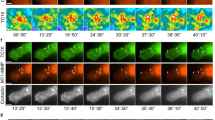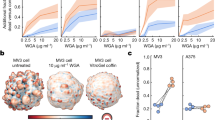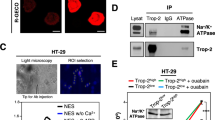Abstract
Despite their profound importance in the development of cancer, the extracellular cues that target cell invasion through basement membrane barriers remain poorly understood1. A central obstacle has been the difficulty of studying the interactions between invading cells and basement membranes in vivo2,3. Using the genetically and visually tractable model of Caenorhabditis elegans anchor cell (AC) invasion, we show that UNC-6 (netrin) signalling, a pathway not previously implicated in controlling cell invasion in vivo, is a key regulator of this process. Site of action studies reveal that before invasion, localized UNC-6 secretion directs its receptor, UNC-40, to the plasma membrane of the AC, in contact with the basement membrane. There, UNC-40 polarizes a specialized invasive membrane domain through the enrichment of actin regulators, F-actin and phosphatidylinositol 4,5-bisphosphate (PtdIns(4,5)P2). Cell ablation experiments indicate that UNC-6 promotes the formation of invasive protrusions from the AC that break down the basement membrane in response to a subsequent vulval cue. Together, these results characterize an invasive membrane domain in vivo, and reveal a role for UNC-6 (netrin) in polarizing this domain towards its basement membrane target.
This is a preview of subscription content, access via your institution
Access options
Subscribe to this journal
Receive 12 print issues and online access
$209.00 per year
only $17.42 per issue
Buy this article
- Purchase on Springer Link
- Instant access to full article PDF
Prices may be subject to local taxes which are calculated during checkout





Similar content being viewed by others
References
Machesky, L., Jurdic, P. & Hinz, B. Grab, stick, pull and digest: the functional diversity of actin-associated matrix-adhesion structures. Workshop on invadopodia, podosomes and focal adhesions in tissue invasion. EMBO Rep. 9, 139–143 (2008).
Even-Ram, S. & Yamada, K. M. Cell migration in 3D matrix. Curr. Opin. Cell Biol. 17, 524–532 (2005).
Hotary, K., Li, X. Y., Allen, E., Stevens, S. L. & Weiss, S. J. A cancer cell metalloprotease triad regulates the basement membrane transmigration program. Genes Dev. 20, 2673–2686 (2006).
Sharma-Kishore, R., White, J. G., Southgate, E. & Podbilewicz, B. Formation of the vulva in Caenorhabditis elegans: a paradigm for organogenesis. Development 126, 691–699 (1999).
Sherwood, D. R. & Sternberg, P. W. Anchor cell invasion into the vulval epithelium in C. elegans. Dev. Cell 5, 21–31 (2003).
Hwang, B. J., Meruelo, A. D. & Sternberg, P. W. C. elegans EVI1 proto-oncogene, EGL-43, is necessary for Notch-mediated cell fate specification and regulates cell invasion. Development 134, 669–679 (2007).
Rimann, I. & Hajnal, A. Regulation of anchor cell invasion and uterine cell fates by the egl-43 Evi-1 proto-oncogene in Caenorhabditis elegans. Dev. Biol. 308, 187–195 (2007).
Sherwood, D. R., Butler, J. A., Kramer, J. M. & Sternberg, P. W. FOS-1 promotes basement-membrane removal during anchor-cell invasion in C. elegans. Cell 121, 951–962 (2005).
Baker, K. A., Moore, S. W., Jarjour, A. A. & Kennedy, T. E. When a diffusible axon guidance cue stops diffusing: roles for netrins in adhesion and morphogenesis. Curr. Opin. Neurobiol. 16, 529–534 (2006).
Hedgecock, E. M., Culotti, J. G. & Hall, D. H. The unc-5, unc-6, and unc-40 genes guide circumferential migrations of pioneer axons and mesodermal cells on the epidermis in C. elegans. Neuron 4, 61–85 (1990).
Asakura, T., Ogura, K. & Goshima, Y. UNC-6 expression by the vulval precursor cells of Caenorhabditis elegans is required for the complex axon guidance of the HSN neurons. Dev. Biol. 304, 800–810 (2007).
Wadsworth, W. G., Bhatt, H. & Hedgecock, E. M. Neuroglia and pioneer neurons express UNC-6 to provide global and local netrin cues for guiding migrations in C. elegans. Neuron 16, 35–46 (1996).
Burdine, R. D., Branda, C. S. & Stern, M. J. EGL-17(FGF) expression coordinates the attraction of the migrating sex myoblasts with vulval induction in C. elegans. Development 125, 1083–1093 (1998).
Adler, C. E., Fetter, R. D. & Bargmann, C. I. UNC-6/netrin induces neuronal asymmetry and defines the site of axon formation. Nature Neurosci. 9, 511–518 (2006).
Gitai, Z., Yu, T. W., Lundquist, E. A., Tessier-Lavigne, M. & Bargmann, C. I. The netrin receptor UNC-40/DCC stimulates axon attraction and outgrowth through enabled and, in parallel, Rac and UNC-115/AbLIM. Neuron 37, 53–65 (2003).
Lundquist, E. A., Reddien, P. W., Hartwieg, E., Horvitz, H. R. & Bargmann, C. I. Three C. elegans Rac proteins and several alternative Rac regulators control axon guidance, cell migration and apoptotic cell phagocytosis. Development 128, 4475–4488 (2001).
Edwards, K. A., Demsky, M., Montague, R. A., Weymouth, N. & Kiehart, D. P. GFP-moesin illuminates actin cytoskeleton dynamics in living tissue and demonstrates cell shape changes during morphogenesis in Drosophila. Dev. Biol. 191, 103–117 (1997).
Janmey, P. A. & Lindberg, U. Cytoskeletal regulation: rich in lipids. Nature Rev. Mol. Cell Biol. 5, 658–666 (2004).
Heo, W. D. et al. PI(3, 4, 5)P3 and PI(4, 5)P2 lipids target proteins with polybasic clusters to the plasma membrane. Science 314, 1458–1461 (2006).
Rescher, U., Ruhe, D., Ludwig, C., Zobiack, N. & Gerke, V. Annexin 2 is a phosphatidylinositol (4, 5)-bisphosphate binding protein recruited to actin assembly sites at cellular membranes. J. Cell Sci. 117, 3473–3480 (2004).
Colon-Ramos, D. A., Margeta, M. A. & Shen, K. Glia promote local synaptogenesis through UNC-6 (netrin) signalling in C. elegans. Science 318, 103–106 (2007).
Fitamant, J. et al. Netrin-1 expression confers a selective advantage for tumour cell survival in metastatic breast cancer. Proc. Natl Acad. Sci. USA 105, 4850–4855 (2008).
Rodrigues, S., De Wever, O., Bruyneel, E., Rooney, R. J. & Gespach, C. Opposing roles of netrin-1 and the dependence receptor DCC in cancer cell invasion, tumour growth and metastasis. Oncogene 26, 5615–5625 (2007).
Nguyen, A. & Cai, H. Netrin-1 induces angiogenesis via a DCC-dependent ERK1/2-eNOS feed-forward mechanism. Proc. Natl Acad. Sci. USA 103, 6530–6535 (2006).
Park, K. W. et al. The axonal attractant Netrin-1 is an angiogenic factor. Proc. Natl Acad. Sci. USA 101, 16210–16215 (2004).
Wilson, B. D. et al. Netrins promote developmental and therapeutic angiogenesis. Science 313, 640–644 (2006).
Heissig, B., Hattori, K., Friedrich, M., Rafii, S. & Werb, Z. Angiogenesis: vascular remodelling of the extracellular matrix involves metalloproteinases. Curr. Opin. Haematol. 10, 136–141 (2003).
Kao, G., Huang, C. C., Hedgecock, E. M., Hall, D. H. & Wadsworth, W. G. The role of the laminin beta subunit in laminin heterotrimer assembly and basement membrane function and development in C. elegans. Dev. Biol. 290, 211–219 (2006).
Hobert, O. PCR fusion-based approach to create reporter gene constructs for expression analysis in transgenic C. elegans. Biotechniques 32, 728–730 (2002).
Acknowledgements
We are grateful to C. Bargmann for the GFP::unc-34 and unc-40::GFP vectors, the hs>unc-6::HA integrated strain, and advice; W. Wadsworth for the Lam-1::GFP vector; E. Lundquist for the GFP::ced-10 vector; Y. Goshima for Venus::unc-6 strains; D. Kiehart for the moeADB::GFP vector; the Caenorhabditis Genetics Center for providing strains; and N. Sherwood, Z. Wang, G. Lopez, G. Miley and D. Matus for comments on the manuscript. This work was supported by a Basil O'Connor Award, Pew Scholars Award, and NIH Grant GM079320 to D.R.S.
Author information
Authors and Affiliations
Contributions
A.A., D.R.S. and J.W. Z. generated the fluorescent markers, C. elegans transgenic lines and genetic stocks used in this study. The AC invasion phenotypes in unc-6 and unc-40 mutants were originally observed by D.R.S.; D.R.S. and J.W.Z. designed the experiments described in the paper; D.R.S., E.J.H. and J.W.Z. performed the experiments and analysed the data.
Corresponding author
Ethics declarations
Competing interests
The authors declare no competing financial interests.
Supplementary information
Supplementary Information
Supplementary Information (PDF 1145 kb)
Supplementary Information
Supplementary Movie 1 (MOV 4371 kb)
Supplementary Information
Supplementary Movie 2 (MOV 7107 kb)
Rights and permissions
About this article
Cite this article
Ziel, J., Hagedorn, E., Audhya, A. et al. UNC-6 (netrin) orients the invasive membrane of the anchor cell in C. elegans. Nat Cell Biol 11, 183–189 (2009). https://doi.org/10.1038/ncb1825
Received:
Accepted:
Published:
Issue Date:
DOI: https://doi.org/10.1038/ncb1825
This article is cited by
-
Prolonging somatic cell proliferation through constitutive hox gene expression in C. elegans
Nature Communications (2023)
-
Pioneer axons employ Cajal’s battering ram to enter the spinal cord
Nature Communications (2019)
-
RNA Sequencing of Carboplatin- and Paclitaxel-Resistant Endometrial Cancer Cells Reveals New Stratification Markers and Molecular Targets for Cancer Treatment
Hormones and Cancer (2018)
-
Cell division and targeted cell cycle arrest opens and stabilizes basement membrane gaps
Nature Communications (2014)
-
Basement membrane sliding and targeted adhesion remodels tissue boundaries during uterine–vulval attachment in Caenorhabditis elegans
Nature Cell Biology (2011)



